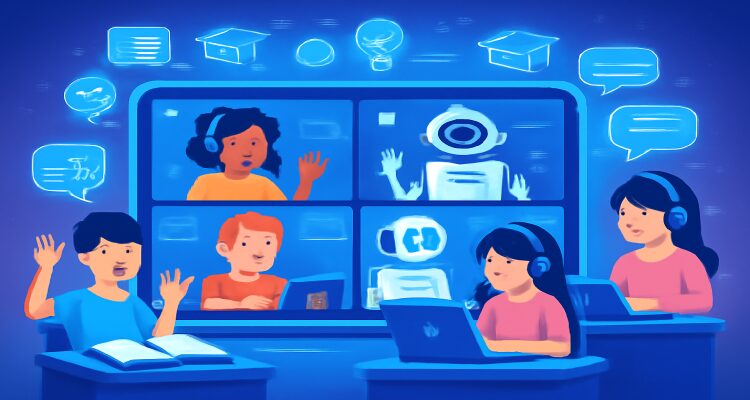Education Without Teachers? The Rise of Peer-to-Peer AI Tutoring
The rise of peer-to-peer AI tutoring is transforming education, offering personalized guidance without traditional teachers. What does this mean for the future of learning?
Introduction: A Classroom Without Teachers?
Imagine logging into a virtual study group where no teacher is present—yet every question is answered, explained, and expanded upon instantly. Instead of chalkboards and lectures, students lean on AI-powered peers who guide, correct, and even encourage them in real time. This scenario isn’t science fiction anymore; it’s the emerging frontier of peer-to-peer AI tutoring, a movement reshaping how we understand the role of teachers, students, and technology in education.
Context & Background: From Chalkboard to Chatbots
For centuries, formal education has been teacher-centered. The classroom dynamic positioned instructors as the source of knowledge, while students absorbed information at a relatively uniform pace. This model faced criticism, especially in recent decades, for failing to meet diverse learning needs.
The digital revolution introduced new tools—online courses, interactive platforms, and global resource libraries. Then came AI: first as grammar checkers, then as adaptive learning platforms, and finally as intelligent tutors capable of holding conversations, offering explanations, and personalizing content in ways humans struggled to scale.
Peer-to-peer models traditionally meant students tutoring each other. With AI joining the mix, the “peer” role has expanded. Now, learners can rely on AI-powered study companions that act less like instructors and more like classmates collaborating on shared goals.
Main Developments: How AI Peer Tutoring Works
Today’s peer-to-peer AI tutoring platforms work differently from conventional online classes:
-
Personalized Learning Paths: AI adapts explanations to a student’s pace, knowledge level, and even preferred learning style.
-
Collaborative Simulations: Instead of lectures, learners interact with AI “peers” that simulate group study sessions.
-
On-Demand Support: Instant responses fill gaps often left in overcrowded classrooms.
-
Scalable Affordability: Unlike one-on-one human tutoring, AI systems deliver individualized attention to thousands simultaneously.
Startups and ed-tech giants alike are experimenting with these models. For example:
-
AI companions integrated into LMS platforms are helping university students prepare for exams.
-
Peer-learning forums with embedded AI bots are transforming Q&A sections into dynamic micro-lessons.
-
Skill-based apps use AI to “co-study” with learners, mimicking peer discussions while reinforcing memory.
These developments are not about replacing education wholesale, but about redefining who—or what—a “peer” can be in learning environments.
Expert Insight & Public Reaction
Reactions from educators and students vary. Many see opportunity, while others express caution.
Dr. Anika Sharma, an education technology researcher at Delhi University, notes:
“AI peer-to-peer tutoring is not about removing teachers—it’s about filling the gaps. In large systems where a single teacher manages 50 students, AI provides the ‘extra hands’ that make personalized learning possible.”
Students, particularly in higher education and test-prep domains, are embracing the change. Some describe AI peers as “non-judgmental classmates” who are always available.
Yet, concerns exist. Parents worry about over-dependence on AI; teachers fear being sidelined; and ethicists warn of bias in AI explanations.
Michael Turner, a high school principal in the U.S., cautions:
“We must not confuse access to information with wisdom. AI tutoring is powerful, but without human mentorship, students risk losing the social and emotional dimensions of learning.”
Impact & Implications: What Happens Next?
The rise of AI peer tutoring holds profound implications:
Education Equity: In underserved regions, AI could close knowledge gaps where qualified teachers are scarce.
Shifting Teacher Roles: Educators may evolve into facilitators and mentors, focusing on critical thinking, creativity, and human interaction—areas where AI still struggles.
EdTech Explosion: Startups offering affordable, peer-based AI tools are attracting investment, suggesting a major shift in the education economy.
Skill Development Over Memorization: Learners may move away from rote learning to dialogue-driven knowledge acquisition.
Ethical & Social Challenges: Ensuring accuracy, reducing bias, and protecting against over-reliance will require careful regulation and public debate.
The ultimate outcome may not be “teacherless” education, but teacher-augmented education, where humans and AI peers collaborate in hybrid ecosystems.
Conclusion: A Redefinition of Learning Communities
Education without teachers is not the question—education without limits is. Peer-to-peer AI tutoring doesn’t eliminate human guidance; it reimagines it. By blending human mentorship with AI “study partners,” the future classroom could be a place where every learner gets individualized attention, every time.
The blackboard has given way to learning networks; and now, the boundaries between peer and tutor, student and AI, classroom and community, are blurring. The challenge ahead is ensuring this shift strengthens—not weakens—the human essence of education.
Disclaimer: This article is for informational and educational purposes only. It does not endorse any specific product, company, or technology.











